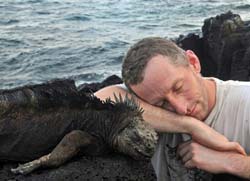Darwin in the genome

A current controversy raging in evolutionary biology is about whether adaptation to new environments is the result of many genes, each of relatively small effect, or just a few genes of large effect. A new study published in Molecular Ecology strongly supports the first “many-small” hypothesis.
McGill University professor Andrew Hendry, from the Department of Biology and the Redpath Museum, and evolutionary geneticists at Basel University in Switzerland, studied how threespine stickleback fish adapted to lake and stream environments in British Columbia, Canada.
The authors used cutting-edge genomic methods to test for genetic differences at thousands of positions (“loci”) scattered across the stickleback genome. Very large genetic differences between lake and stream stickleback were discovered at more than a dozen of these loci, which is considerably more than expected under the alternative “few-large” hypothesis.
By examining four independently evolved lake-stream population pairs, the researchers were further able to show that increasing divergence between the populations involved genetic differences that were larger and present at more and more loci.
As these results were obtained using new high-resolution genetic methods, it is conceivable that previous perceptions of adaptation as being a genetically simple process are simply the result of a bias resulting from previous lower-resolution genomic methods.
“I suspect that as more and more studies use these methods, the tide of opinion will swerve strongly to the view that adaptation is a complex process that involves many genes spread across diverse places in the genome,” says Prof. Hendry.
To read the full paper: http://onlinelibrary.wiley.com/doi/10.1111/j.1365-294X.2012.05509.x/abstract
Media Contact
More Information:
http://www.mcgill.caAll latest news from the category: Life Sciences and Chemistry
Articles and reports from the Life Sciences and chemistry area deal with applied and basic research into modern biology, chemistry and human medicine.
Valuable information can be found on a range of life sciences fields including bacteriology, biochemistry, bionics, bioinformatics, biophysics, biotechnology, genetics, geobotany, human biology, marine biology, microbiology, molecular biology, cellular biology, zoology, bioinorganic chemistry, microchemistry and environmental chemistry.
Newest articles

Properties of new materials for microchips
… can now be measured well. Reseachers of Delft University of Technology demonstrated measuring performance properties of ultrathin silicon membranes. Making ever smaller and more powerful chips requires new ultrathin…

Floating solar’s potential
… to support sustainable development by addressing climate, water, and energy goals holistically. A new study published this week in Nature Energy raises the potential for floating solar photovoltaics (FPV)…

Skyrmions move at record speeds
… a step towards the computing of the future. An international research team led by scientists from the CNRS1 has discovered that the magnetic nanobubbles2 known as skyrmions can be…





















